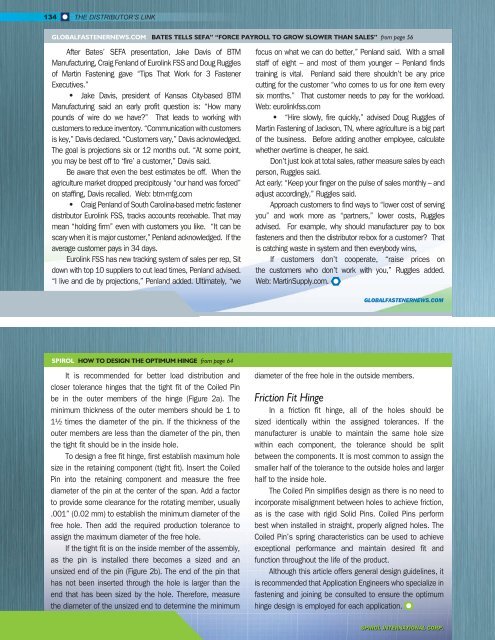SUMMER 2016
Distributor's Link Magazine Summer Issue 2016 / Vol 39 No3
Distributor's Link Magazine Summer Issue 2016 / Vol 39 No3
You also want an ePaper? Increase the reach of your titles
YUMPU automatically turns print PDFs into web optimized ePapers that Google loves.
134<br />
THE DISTRIBUTOR’S LINK<br />
GLOBALFASTENERNEWS.COM BATES TELLS SEFA” “FORCE PAYROLL TO GROW SLOWER THAN SALES” from page 56<br />
After Bates’ SEFA presentation, Jake Davis of BTM<br />
Manufacturing, Craig Fenland of Eurolink FSS and Doug Ruggles<br />
of Martin Fastening gave “Tips That Work for 3 Fastener<br />
Executives.”<br />
• Jake Davis, president of Kansas City-based BTM<br />
Manufacturing said an early profit question is: “How many<br />
pounds of wire do we have?” That leads to working with<br />
customers to reduce inventory. “Communication with customers<br />
is key,” Davis declared. “Customers vary,” Davis acknowledged.<br />
The goal is projections six or 12 months out. “At some point,<br />
you may be best off to ‘fire’ a customer,” Davis said.<br />
Be aware that even the best estimates be off. When the<br />
agriculture market dropped precipitously “our hand was forced”<br />
on staffing, Davis recalled. Web: btm-mfg.com<br />
• Craig Penland of South Carolina-based metric fastener<br />
distributor Eurolink FSS, tracks accounts receivable. That may<br />
mean “holding firm” even with customers you like. “It can be<br />
scary when it is major customer,” Penland acknowledged. If the<br />
average customer pays in 34 days.<br />
Eurolink FSS has new tracking system of sales per rep, Sit<br />
down with top 10 suppliers to cut lead times, Penland advised.<br />
“I live and die by projections,” Penland added. Ultimately, “we<br />
focus on what we can do better,” Penland said. With a small<br />
staff of eight – and most of them younger – Penland finds<br />
training is vital. Penland said there shouldn’t be any price<br />
cutting for the customer “who comes to us for one item every<br />
six months.” That customer needs to pay for the workload.<br />
Web: eurolinkfss.com<br />
• “Hire slowly, fire quickly,” advised Doug Ruggles of<br />
Martin Fastening of Jackson, TN, where agriculture is a big part<br />
of the business. Before adding another employee, calculate<br />
whether overtime is cheaper, he said.<br />
Don’t just look at total sales, rather measure sales by each<br />
person, Ruggles said.<br />
Act early: “Keep your finger on the pulse of sales monthly – and<br />
adjust accordingly,” Ruggles said.<br />
Approach customers to find ways to “lower cost of serving<br />
you” and work more as “partners,” lower costs, Ruggles<br />
advised. For example, why should manufacturer pay to box<br />
fasteners and then the distributor re-box for a customer? That<br />
is catching waste in system and then everybody wins,<br />
If customers don’t cooperate, “raise prices on<br />
the customers who don’t work with you,” Ruggles added.<br />
Web: MartinSupply.com.<br />
GLOBALFASTENERNEWS.COM<br />
SPIROL HOW TO DESIGN THE OPTIMUM HINGE from page 64<br />
It is recommended for better load distribution and<br />
closer tolerance hinges that the tight fit of the Coiled Pin<br />
be in the outer members of the hinge (Figure 2a). The<br />
minimum thickness of the outer members should be 1 to<br />
1½ times the diameter of the pin. If the thickness of the<br />
outer members are less than the diameter of the pin, then<br />
the tight fit should be in the inside hole.<br />
To design a free fit hinge, first establish maximum hole<br />
size in the retaining component (tight fit). Insert the Coiled<br />
Pin into the retaining component and measure the free<br />
diameter of the pin at the center of the span. Add a factor<br />
to provide some clearance for the rotating member, usually<br />
.001” (0.02 mm) to establish the minimum diameter of the<br />
free hole. Then add the required production tolerance to<br />
assign the maximum diameter of the free hole.<br />
If the tight fit is on the inside member of the assembly,<br />
as the pin is installed there becomes a sized and an<br />
unsized end of the pin (Figure 2b). The end of the pin that<br />
has not been inserted through the hole is larger than the<br />
end that has been sized by the hole. Therefore, measure<br />
the diameter of the unsized end to determine the minimum<br />
diameter of the free hole in the outside members.<br />
Friction Fit Hinge<br />
In a friction fit hinge, all of the holes should be<br />
sized identically within the assigned tolerances. If the<br />
manufacturer is unable to maintain the same hole size<br />
within each component, the tolerance should be split<br />
between the components. It is most common to assign the<br />
smaller half of the tolerance to the outside holes and larger<br />
half to the inside hole.<br />
The Coiled Pin simplifies design as there is no need to<br />
incorporate misalignment between holes to achieve friction,<br />
as is the case with rigid Solid Pins. Coiled Pins perform<br />
best when installed in straight, properly aligned holes. The<br />
Coiled Pin’s spring characteristics can be used to achieve<br />
exceptional performance and maintain desired fit and<br />
function throughout the life of the product.<br />
Although this article offers general design guidelines, it<br />
is recommended that Application Engineers who specialize in<br />
fastening and joining be consulted to ensure the optimum<br />
hinge design is employed for each application.<br />
SPIROL INTERNATIONAL CORP.

















